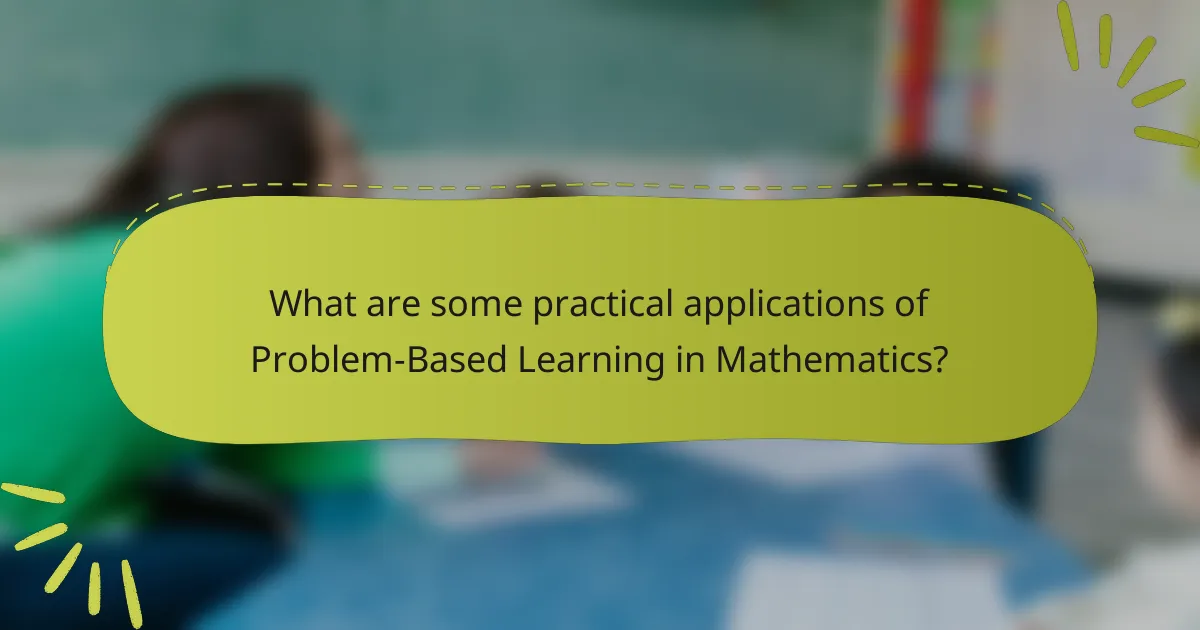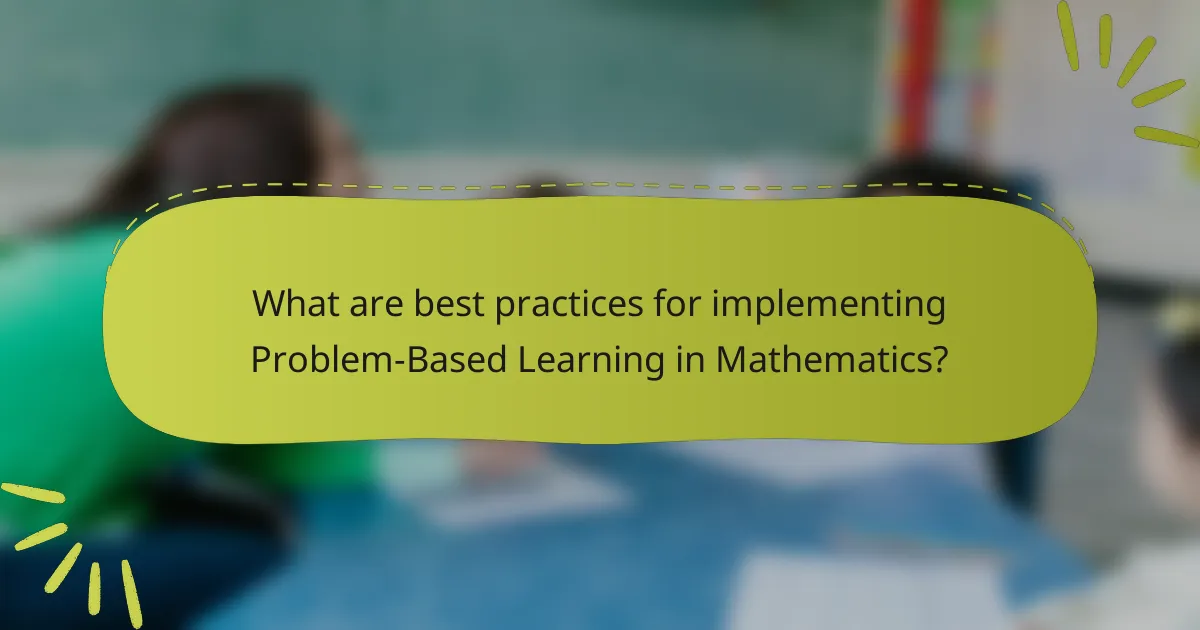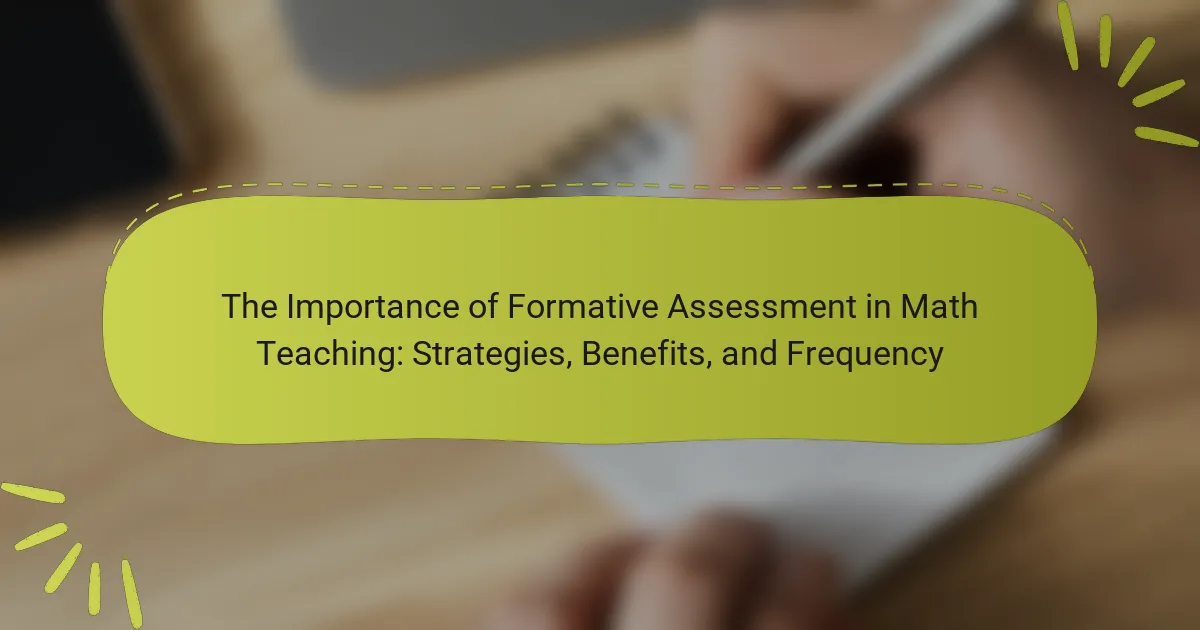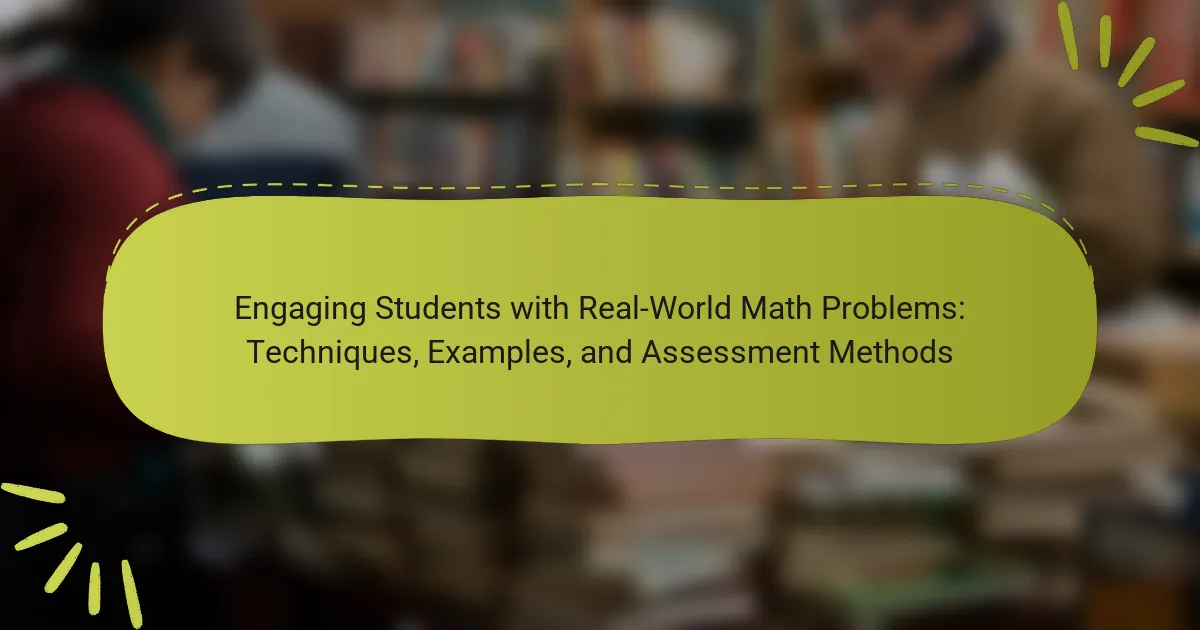Problem-Based Learning (PBL) in Mathematics is an instructional method that immerses students in real-world problem-solving, enhancing their critical thinking and application of mathematical concepts. This approach promotes collaboration, allowing students to identify, question, and solve complex scenarios, leading to improved understanding and retention of mathematical skills. Practical applications of PBL include real-world problem-solving tasks, collaborative projects, and interdisciplinary learning, all of which have been shown to deepen students’ engagement and critical thinking. Effective implementation of PBL involves designing relevant problems, facilitating teamwork, encouraging self-directed learning, focusing assessments on both process and product, and incorporating reflection to enhance retention and application of knowledge. Research supports that these practices contribute to better problem-solving abilities and a stronger grasp of mathematical principles.

What is Problem-Based Learning in Mathematics?
Problem-Based Learning in Mathematics is an instructional method that engages students in solving real-world problems. This approach encourages critical thinking and application of mathematical concepts. Students work collaboratively to explore complex scenarios. They identify problems, formulate questions, and seek solutions. Research shows that this method enhances understanding and retention of mathematical skills. A study by Barrows (1996) highlights improved problem-solving abilities among students using this approach. Problem-Based Learning shifts focus from traditional lectures to active student participation. It fosters a deeper connection with mathematical principles through practical application.
How does Problem-Based Learning differ from traditional learning methods?
Problem-Based Learning (PBL) emphasizes student-centered exploration of real-world problems. In contrast, traditional learning methods focus on teacher-led instruction and rote memorization. PBL encourages critical thinking and collaboration among students. Traditional methods often prioritize individual work and standardized testing. In PBL, students actively engage in research and inquiry-based learning. Traditional learning typically relies on passive absorption of information. Research shows that PBL enhances retention and application of knowledge (Barrows, 1996). This approach fosters deeper understanding and practical skills relevant to real-life situations.
What are the key characteristics of Problem-Based Learning?
Problem-Based Learning (PBL) is characterized by student-centered learning through real-world problems. It encourages active engagement and collaboration among learners. PBL promotes critical thinking and problem-solving skills. Students work in groups to explore complex issues. They research and apply knowledge to devise solutions. The role of the instructor shifts to a facilitator rather than a traditional lecturer. Assessment in PBL focuses on both process and outcomes. This approach enhances retention and application of knowledge.
How is Problem-Based Learning implemented in mathematics classrooms?
Problem-Based Learning (PBL) is implemented in mathematics classrooms through real-world problem scenarios. Teachers present complex, open-ended problems that require students to collaborate and think critically. Students work in groups to explore these problems, fostering teamwork and communication skills. The teacher acts as a facilitator, guiding discussions and providing support when needed. Assessment in PBL focuses on both the process and the final solution, encouraging reflective thinking. Research shows that PBL enhances student engagement and improves problem-solving skills in mathematics. According to a study by Hmelo-Silver (2004), students in PBL environments demonstrate deeper understanding and retention of mathematical concepts.
Why is Problem-Based Learning important in mathematics education?
Problem-Based Learning (PBL) is important in mathematics education because it enhances critical thinking and problem-solving skills. PBL engages students in real-world problems, making learning relevant and applicable. This approach encourages collaboration among students, fostering communication and teamwork. Research shows that PBL improves retention of mathematical concepts. A study by Hmelo-Silver (2004) found that students in PBL environments performed better in applying knowledge than those in traditional settings. Additionally, PBL promotes self-directed learning, empowering students to take charge of their education. It also develops resilience as students navigate challenges and learn from mistakes. Overall, PBL transforms the learning experience, making mathematics more engaging and effective.
What skills does Problem-Based Learning develop in students?
Problem-Based Learning develops critical thinking, problem-solving, collaboration, and self-directed learning skills in students. Critical thinking is enhanced as students analyze complex problems and evaluate solutions. Problem-solving skills are cultivated through real-world scenarios that require innovative thinking. Collaboration is fostered as students work in teams to share ideas and strategies. Self-directed learning skills emerge as students take responsibility for their learning process. Research indicates that these skills are essential for academic success and future career readiness. A study by Hmelo-Silver (2004) highlights that students engaged in Problem-Based Learning demonstrate higher levels of motivation and engagement.
How does Problem-Based Learning enhance critical thinking in mathematics?
Problem-Based Learning enhances critical thinking in mathematics by engaging students in real-world problem-solving. This approach requires learners to analyze complex scenarios and apply mathematical concepts. Students must identify relevant information and devise strategies to tackle challenges. This process fosters deeper understanding and encourages exploration of multiple solutions. Research shows that students involved in Problem-Based Learning demonstrate improved critical thinking skills. A study by Hmelo-Silver (2004) found that such methods promote higher-order thinking and better problem-solving abilities in mathematics. These findings confirm that Problem-Based Learning effectively cultivates critical thinking in mathematical contexts.
What are the main benefits of Problem-Based Learning in Mathematics?
Problem-Based Learning (PBL) in Mathematics enhances critical thinking and problem-solving skills. It encourages students to engage actively with mathematical concepts. PBL fosters collaboration among peers through group work. This method promotes deeper understanding of mathematical principles. Research indicates that PBL improves retention of knowledge. According to a study by Hmelo-Silver (2004), students in PBL environments perform better on assessments. PBL also develops self-directed learning habits. Students learn to seek resources and solutions independently.
How does Problem-Based Learning improve student engagement?
Problem-Based Learning (PBL) enhances student engagement by fostering active participation and critical thinking. PBL encourages learners to solve real-world problems, which makes learning relevant and meaningful. This approach promotes collaboration among students, increasing motivation through teamwork. Research shows that students in PBL environments demonstrate higher levels of interest and retention. A study published in the Journal of Educational Psychology found that PBL significantly boosts student engagement compared to traditional methods. The interactive nature of PBL allows for immediate feedback, further sustaining student interest. Overall, PBL transforms passive learners into active participants in their education.
What impact does Problem-Based Learning have on academic performance?
Problem-Based Learning (PBL) positively impacts academic performance. PBL enhances critical thinking and problem-solving skills. Students engaged in PBL demonstrate higher retention of knowledge. Research indicates that PBL improves collaboration among peers. A study by Hmelo-Silver (2004) found that students in PBL environments performed better on assessments. Additionally, PBL fosters deeper understanding of subject matter. This approach encourages active learning, which is linked to improved academic outcomes. Overall, PBL contributes significantly to students’ academic success in mathematics.
How can educators effectively implement Problem-Based Learning in their teaching?
Educators can effectively implement Problem-Based Learning (PBL) by designing real-world problems that engage students. They should begin by identifying relevant and challenging problems in mathematics. Next, educators must facilitate group discussions to encourage collaboration and critical thinking. Providing resources and guidance is essential for student exploration and research. Regular feedback helps students refine their understanding and approach. Assessment should focus on both the process and the final solution. Research shows that PBL enhances problem-solving skills and student motivation (Barrows, 1996). By following these steps, educators can create an effective PBL environment.
What strategies can teachers use to create effective problem scenarios?
Teachers can use several strategies to create effective problem scenarios. First, they should connect problems to real-world contexts. This relevance increases student engagement and motivation. Second, incorporating collaborative elements encourages teamwork and communication. Group work allows students to share diverse perspectives. Third, varying the complexity of problems caters to different skill levels. This differentiation helps all students access the material. Fourth, using open-ended questions promotes critical thinking. Open questions require students to explore multiple solutions. Lastly, integrating technology can enhance problem scenarios. Tools like simulations provide interactive learning experiences. These strategies collectively foster a rich problem-based learning environment.
How can assessment be integrated into Problem-Based Learning?
Assessment can be integrated into Problem-Based Learning (PBL) through formative and summative evaluation methods. Formative assessments, such as peer reviews and self-assessments, provide ongoing feedback during the learning process. These assessments help students reflect on their understanding and improve their problem-solving skills. Summative assessments, like project presentations or final reports, evaluate the overall learning outcomes after completing a PBL unit. Research indicates that integrating assessments into PBL enhances student engagement and promotes deeper learning. A study by Barrows (1996) found that effective assessment strategies in PBL lead to improved critical thinking and collaboration among students.

What are some practical applications of Problem-Based Learning in Mathematics?
Practical applications of Problem-Based Learning in Mathematics include real-world problem solving, collaborative projects, and interdisciplinary learning. In real-world problem solving, students tackle authentic mathematical challenges that mimic situations they may encounter outside the classroom. Collaborative projects involve students working in teams to explore mathematical concepts and develop solutions. Interdisciplinary learning integrates mathematics with subjects like science or social studies, enhancing relevance and engagement. Research shows that these applications improve critical thinking and retention of mathematical concepts. For instance, a study by Hmelo-Silver (2004) highlights that students engaged in problem-based learning demonstrate deeper understanding and application of mathematics in varied contexts.
How can real-world problems be incorporated into mathematics lessons?
Real-world problems can be incorporated into mathematics lessons by using practical examples that students encounter daily. Teachers can design activities around budgeting, shopping, or cooking to illustrate mathematical concepts. For instance, calculating discounts or measuring ingredients requires the application of arithmetic and fractions. Real-world scenarios make abstract concepts tangible and relatable. According to research by the National Council of Teachers of Mathematics, this approach enhances student engagement and understanding. Students learn to apply mathematical reasoning to solve relevant problems, improving their critical thinking skills. Integrating real-world problems fosters a deeper appreciation for mathematics in everyday life.
What examples exist of successful Problem-Based Learning projects?
Successful Problem-Based Learning projects include the “Medical School Curriculum” at McMaster University. This program emphasizes real-world medical cases. Students engage in collaborative problem-solving. It enhances critical thinking and clinical skills. Another example is the “Engineering Design Challenge” at Stanford University. Students tackle real engineering problems. They work in teams to develop solutions. This approach fosters innovation and practical application of knowledge. Lastly, the “Community-Based Learning” project at the University of Wisconsin integrates local community issues. Students apply their learning to address these challenges. These projects demonstrate the effectiveness of Problem-Based Learning in various fields.
How do students respond to real-world applications in mathematics?
Students generally respond positively to real-world applications in mathematics. They find these applications engaging and relevant. Real-world scenarios help students understand mathematical concepts better. This relevance increases their motivation to learn. Research indicates that students retain information longer when they see practical uses. A study by Hattie (2009) highlights that real-world connections improve student achievement. Engaging with real-world problems fosters critical thinking skills. Students also report higher satisfaction in learning when applying math to real-life situations. Overall, real-world applications enhance students’ learning experiences in mathematics.
What challenges might educators face when using Problem-Based Learning?
Educators may face several challenges when using Problem-Based Learning (PBL). One significant challenge is the need for substantial preparation time. Educators must design relevant problems that align with learning objectives. This can be time-consuming and requires careful planning.
Another challenge is managing diverse student abilities. In PBL, students often work in groups, which can lead to disparities in participation and understanding. Some students may dominate discussions while others may struggle to contribute.
Assessment can also be difficult in PBL environments. Traditional grading methods may not effectively evaluate student learning. Educators must develop new assessment strategies that reflect individual contributions and group dynamics.
Additionally, educators may encounter resistance from students accustomed to traditional teaching methods. Some students may feel uncomfortable with the open-ended nature of PBL. This discomfort can hinder their engagement and learning.
Lastly, limited resources can pose a challenge. PBL often requires materials and tools that may not be readily available in all educational settings. This can restrict the types of problems educators can implement effectively.
How can teachers overcome resistance to Problem-Based Learning?
Teachers can overcome resistance to Problem-Based Learning (PBL) by providing clear expectations and structured guidance. Establishing a supportive classroom environment is essential. Teachers should model PBL processes to demonstrate effectiveness. They can also engage students with relevant, real-world problems to increase interest. Regular feedback helps students adjust and improve their approaches. Collaborative learning encourages peer support and reduces anxiety. Professional development for teachers enhances their PBL implementation skills. Research shows that structured PBL can lead to improved student outcomes, as evidenced by studies like those from Hmelo-Silver (2004), which highlight the benefits of PBL in fostering critical thinking and problem-solving skills.
What resources are available to support Problem-Based Learning in mathematics?
Resources available to support Problem-Based Learning in mathematics include textbooks, online platforms, and teacher training programs. Textbooks often provide structured problems and case studies. Online platforms like Khan Academy and Coursera offer interactive problem-solving courses. Teacher training programs focus on methodologies for implementing problem-based learning effectively. Additionally, educational websites provide lesson plans and problem sets. Research indicates that these resources enhance student engagement and understanding in mathematics.

What are best practices for implementing Problem-Based Learning in Mathematics?
Implementing Problem-Based Learning (PBL) in Mathematics requires several best practices. First, educators should design real-world problems that are relevant to students. This relevance increases engagement and motivation. Second, teachers must facilitate collaborative group work. Collaboration fosters communication and critical thinking skills. Third, educators should encourage self-directed learning. Students taking ownership of their learning leads to deeper understanding. Fourth, assessment should focus on both process and product. This dual focus provides a comprehensive view of student learning. Finally, reflection is crucial. Students reflecting on their learning experiences enhances retention and application of knowledge. Research shows that these practices lead to improved problem-solving skills and greater conceptual understanding in mathematics.
How can teachers foster a collaborative learning environment?
Teachers can foster a collaborative learning environment by implementing structured group activities. These activities encourage students to work together towards common goals. Establishing clear roles within groups promotes accountability. Regularly rotating group members enhances diverse perspectives. Providing collaborative tools, such as shared digital platforms, facilitates communication. Teachers should model collaborative behavior to set expectations. Encouraging reflective discussions after group work reinforces learning outcomes. Research shows that collaborative learning improves problem-solving skills and academic performance.
What role does feedback play in Problem-Based Learning?
Feedback plays a crucial role in Problem-Based Learning (PBL) by enhancing student understanding and guiding their learning process. It helps students reflect on their problem-solving approaches. This reflection fosters deeper learning and critical thinking skills. Regular feedback allows students to identify their strengths and areas for improvement. Studies show that timely feedback can significantly increase student engagement and motivation. Research indicates that effective feedback can lead to improved academic outcomes. For instance, a study by Hattie and Timperley (2007) highlights the importance of feedback in promoting learning. Their work suggests that feedback is one of the most powerful influences on student achievement.
What tips can educators use to maximize the effectiveness of Problem-Based Learning?
Educators can maximize the effectiveness of Problem-Based Learning (PBL) by designing relevant, real-world problems. These problems should engage students and encourage critical thinking. Facilitating collaboration among students enhances problem-solving skills. Providing guidance and support is essential for navigating complex challenges. Regularly assessing student progress helps tailor instruction to their needs. Encouraging reflection on the learning process fosters deeper understanding. Integrating interdisciplinary approaches enriches the learning experience. Research shows that effective PBL increases student engagement and retention of knowledge.
How can technology enhance Problem-Based Learning experiences?
Technology enhances Problem-Based Learning experiences by facilitating collaboration and access to resources. Digital tools enable real-time communication among students and instructors. Platforms like Google Classroom or Microsoft Teams allow for seamless interaction. Access to online databases and research materials enriches problem-solving tasks. Interactive simulations provide practical applications of theoretical concepts. Data analytics can track student progress and engagement. Virtual reality can create immersive learning environments. These advancements lead to deeper understanding and increased motivation among learners.
What common pitfalls should teachers avoid when implementing Problem-Based Learning?
Teachers should avoid several common pitfalls when implementing Problem-Based Learning (PBL). One major pitfall is providing insufficient guidance. Without adequate support, students may struggle to navigate complex problems. Another issue is failing to align problems with learning objectives. Misalignment can lead to confusion and hinder learning outcomes. Additionally, teachers should avoid over-scaffolding, which can limit student autonomy and critical thinking. Underestimating the time required for PBL is also a frequent mistake. Effective PBL often takes longer than traditional methods. Lastly, neglecting to assess both process and product can result in incomplete evaluations of student learning. These pitfalls can significantly impact the effectiveness of PBL in mathematics education.
Problem-Based Learning (PBL) in Mathematics is an instructional approach that engages students in solving real-world problems, fostering critical thinking and collaboration. This article provides an overview of PBL, highlighting its differences from traditional learning methods, key characteristics, and implementation strategies in mathematics classrooms. It discusses the importance of PBL in enhancing student engagement, critical thinking, and problem-solving skills, along with practical applications and assessment methods. Additionally, the article addresses challenges educators may face and offers best practices for effectively integrating PBL into mathematics education.



